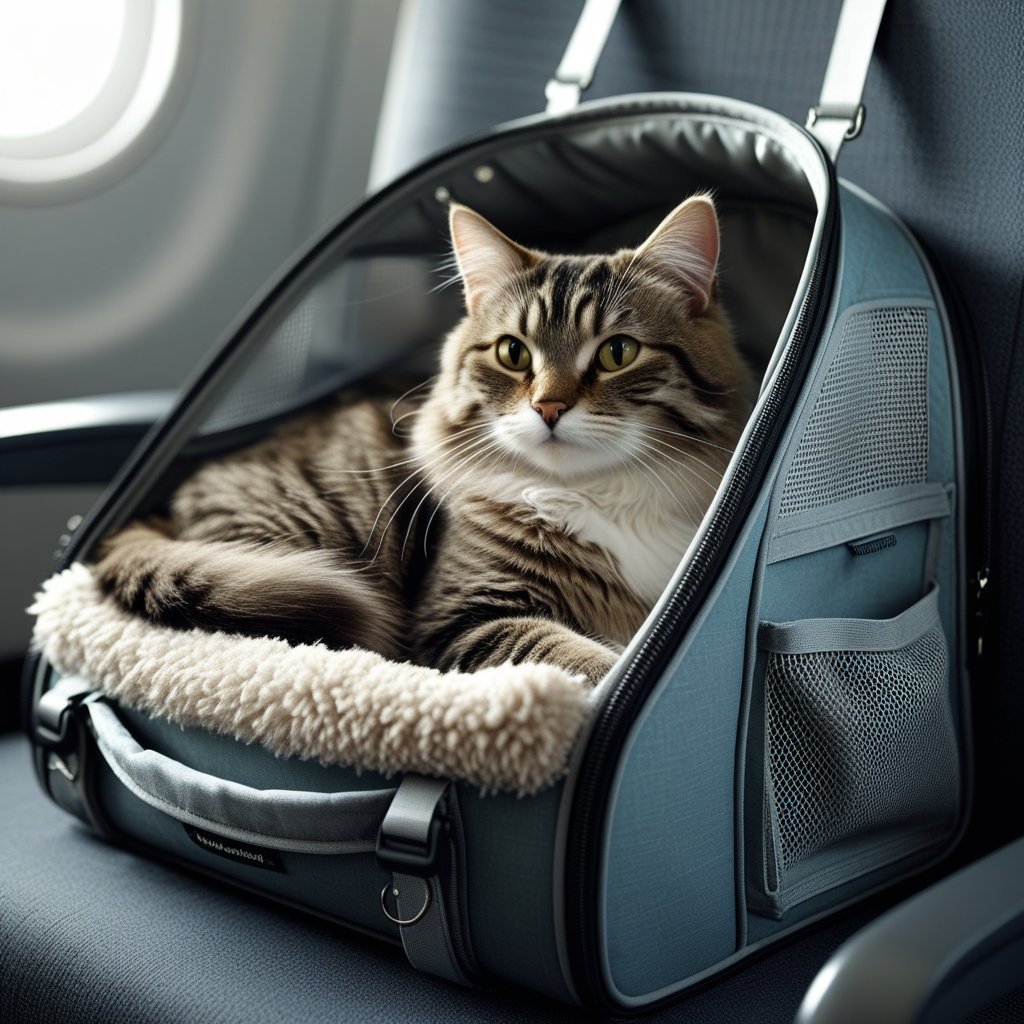Meta Description: Learn how to travel with cats safely and stress-free! Expert tips for car trips, flying with cats, and making travel comfortable for your feline companion.
Traveling with cats can feel like an impossible challenge, given their reputation for preferring familiar routines and comfortable home environments. Unlike dogs who often view car rides as exciting adventures, most cats consider travel a stressful disruption to their carefully ordered world. However, with proper preparation, the right equipment, and proven stress-reduction techniques, traveling with your feline companion can become a manageable – and even enjoyable – experience for both of you.
Whether you’re planning a cross-country move, a vacation where your cat needs to accompany you, or simply need to transport your cat to a new veterinarian across town, understanding how to minimize travel stress is crucial for your cat’s wellbeing and your peace of mind. Cats are creatures of habit who thrive on predictability, making the unfamiliar sights, sounds, and sensations of travel particularly challenging for them to process and accept.
From selecting the perfect carrier and preparing your cat weeks in advance to managing motion sickness and navigating airline regulations, successful cat travel requires careful planning and patient execution. This comprehensive guide will equip you with expert strategies, practical tips, and proven techniques that transform stressful journeys into calm, comfortable experiences that strengthen rather than strain your bond with your feline friend.
Understanding Feline Travel Anxiety
Before diving into practical travel tips, it’s essential to understand why travel is inherently stressful for cats and how this knowledge can inform better travel strategies.
The Psychology of Cat Stress
Territorial Creatures: Cats are strongly territorial animals who feel most secure in familiar environments where they know every scent, sound, and hiding spot. Travel removes them from their established territory and thrusts them into unfamiliar environments filled with unknown stimuli.
Routine Dependence: Cats thrive on predictable routines for feeding, sleeping, playing, and elimination. Travel disrupts these established patterns, creating anxiety about when and where their basic needs will be met.
Control and Predictability: Cats prefer to control their interactions with their environment. During travel, they lose this control and must rely entirely on their humans for safety and comfort, which can be deeply unsettling for independent-minded felines.
Sensory Overload: Travel exposes cats to overwhelming amounts of unfamiliar stimuli – new smells, sounds, movements, and visual experiences that their brains must process simultaneously, often leading to stress responses.

Physical Manifestations of Travel Stress
Panting and Heavy Breathing: Unlike dogs, cats don’t normally pant, so this behavior during travel typically indicates significant stress or overheating.
Excessive Vocalization: Stressed cats may cry, yowl, or meow continuously during travel, expressing their discomfort and seeking reassurance.
Elimination Accidents: Fear and anxiety can cause cats to lose control of their bladder or bowels, even if they’re normally perfectly house-trained.
Drooling and Nausea: Motion sickness and stress can cause excessive salivation and vomiting during travel.
Hiding and Withdrawal: Some cats respond to travel stress by trying to make themselves as small and invisible as possible, often accompanied by trembling or panting.
Breed and Personality Considerations
Confident vs. Anxious Personalities: Naturally confident cats like many Maine Coons or Ragdolls may adapt to travel more easily than naturally anxious cats who prefer solitude and routine.
Early Socialization Impact: Cats exposed to various experiences during their early socialization period (2-7 weeks) often handle new situations, including travel, better than those with limited early exposure.
Previous Travel Experiences: Cats with positive or neutral travel experiences may be more accepting of future trips, while those with traumatic travel memories may require extra patience and preparation.

Pre-Travel Preparation: Setting the Foundation for Success
Successful cat travel begins weeks before your departure date with systematic preparation that gradually acclimates your cat to travel-related experiences.
Carrier Training and Familiarization
Carrier Selection: Choose a carrier that’s large enough for your cat to stand, turn around, and lie down comfortably, but not so large that they feel insecure. Hard-sided carriers provide better protection, while soft-sided options may be more comfortable for some cats.
Home Integration: Place the carrier in your cat’s favorite room with the door open, allowing them to explore and investigate at their own pace. Make the carrier appealing by placing comfortable bedding, treats, or toys inside.
Positive Associations: Feed your cat meals near or inside the carrier to create positive associations. Gradually progress from feeding nearby to feeding inside with the door open, then eventually with the door closed for short periods.
Practice Sessions: Once your cat is comfortable in the carrier, practice short “trips” around the house, gradually increasing duration and movement. Start with simply carrying the carrier a few steps, then progress to longer distances.
Gradual Exposure Training
Car Familiarity: Before actual travel, allow your cat to spend time in a stationary car with the engine off, then progress to short periods with the engine running but no movement.
Motion Introduction: Begin with very short drives around the block, gradually increasing distance and duration as your cat becomes more comfortable with the motion and sounds of car travel.
Timing Strategy: Start carrier and car training at least 2-4 weeks before travel to allow adequate time for gradual adjustment without rushing the process.
Health and Documentation Preparation
Veterinary Consultation: Schedule a pre-travel veterinary examination to ensure your cat is healthy enough for travel and discuss any concerns about motion sickness or anxiety management.
Health Certificates: Many states and all airline travel require health certificates issued within 10 days of travel. International travel may require additional documentation and quarantine periods.
Vaccination Updates: Ensure all vaccinations are current and you have documentation readily available. Some destinations have specific vaccination requirements.
Microchip Verification: Verify that your cat’s microchip information is current and consider updating it with travel destination contact information if you’ll be staying somewhere for extended periods.
Essential Travel Equipment and Supplies
Having the right equipment makes an enormous difference in travel comfort and safety for both you and your cat.
Carrier Essentials

Size and Safety Standards: Choose carriers approved for airline travel if flying, even if you’re currently planning car travel. This ensures you have versatile, high-quality equipment for future needs.
Ventilation Requirements: Adequate ventilation is crucial, especially during warm weather or extended travel periods. Look for carriers with ventilation on multiple sides.
Security Features: Ensure carriers have secure, escape-proof closures. Stressed cats can become surprisingly resourceful escape artists when panicked.
Comfort Additions: Include familiar bedding that smells like home, but avoid favorite blankets that would be devastating to lose. Consider disposable alternatives for easy cleanup.
Travel Comfort Items
Familiar Scents: Bring items that smell like home, such as a piece of your clothing or bedding from your cat’s favorite sleeping spot.
Synthetic Pheromones: Products like Feliway spray can be applied to the carrier or surrounding area to provide calming pheromone signals that reduce anxiety.
Favorite Toys: Include one or two small, familiar toys that provide comfort without taking up excessive space in the carrier.

Collapsible Food and Water Bowls: Lightweight, collapsible bowls save space while ensuring your cat can eat and drink comfortably during stops.
Emergency and Practical Supplies
First Aid Kit: Include basic first aid supplies, any regular medications, and emergency contact information for veterinarians along your route.
Cleaning Supplies: Pack paper towels, disposable wipes, and plastic bags for quick cleanup of any accidents during travel.
Extra Supplies: Bring extra food, litter, and any medications in case of travel delays or unexpected circumstances.
Identification Backup: Carry recent photos of your cat and backup identification in case your cat accidentally escapes during travel.
Car Travel Strategies
Car travel offers the most control over your cat’s travel environment and allows for flexibility in scheduling and stops.
Vehicle Preparation
Climate Control: Pre-cool or pre-heat your vehicle to a comfortable temperature before loading your cat. Never leave cats unattended in vehicles, as temperatures can become dangerous quickly.
Secure Positioning: Place the carrier in a location where it won’t slide or tip during turns and stops. The back seat floor or secured back seat position is often ideal.
Noise Reduction: Keep music volume low and avoid sudden loud sounds that might startle your cat. Some cats find soft classical music or nature sounds calming.
Window Covering: Consider covering carrier windows partially to reduce visual stimulation while still allowing your cat to see out if they choose.
During the Journey
Driving Techniques: Drive smoothly with gradual acceleration, gentle turns, and early braking to minimize motion that might upset your cat’s stomach or increase anxiety.
Regular Breaks: Plan stops every 2-3 hours to check on your cat, offer water, and provide bathroom opportunities if your cat is harness-trained or comfortable with portable litter boxes.
Monitoring Signs: Watch for signs of overheating, excessive stress, or motion sickness. Be prepared to adjust plans if your cat shows concerning symptoms.
Communication: Talk to your cat in calm, reassuring tones throughout the journey. Many cats find their owner’s voice comforting during stressful situations.
Managing Motion Sickness
Pre-Travel Fasting: Withhold food for 12 hours before travel to reduce the likelihood of vomiting, but ensure water remains available until departure.
Medication Options: Consult your veterinarian about anti-nausea medications or mild sedatives if your cat has a history of severe motion sickness.
Fresh Air Circulation: Ensure adequate ventilation without creating drafts that might make your cat uncomfortable.
Positioning Strategy: Some cats experience less motion sickness when they can see forward rather than sideways during travel.
Air Travel with Cats

Flying with cats requires additional planning and preparation due to airline regulations, security procedures, and the unique stresses of air travel.
Airline Policies and Regulations
In-Cabin vs. Cargo: Most airlines allow small cats to travel in-cabin for an additional fee, which is generally safer and less stressful than cargo travel. Each airline has specific size and weight restrictions for in-cabin pet carriers.
Reservation Requirements: Pet reservations are typically required and may be limited per flight. Book pet reservations as early as possible, especially during busy travel seasons.
Health Documentation: Airlines require health certificates issued within 10 days of travel, and international flights may have additional requirements including quarantine periods.
Carrier Specifications: Airlines have strict requirements for pet carrier dimensions, materials, and ventilation. Verify that your carrier meets specific airline requirements before travel.
Airport Navigation
Security Procedures: Be prepared to remove your cat from their carrier during security screening. Practice this process at home and consider bringing a harness for additional security during screening.
Timing Considerations: Arrive at the airport earlier than usual to allow extra time for pet-related procedures and potential complications.
Gate Area Management: Keep your cat’s carrier covered or partially covered in busy gate areas to reduce visual stimulation and stress from crowds.
Boarding Strategy: Take advantage of pre-boarding opportunities offered to passengers traveling with pets to get settled before the general boarding chaos.
In-Flight Considerations
Carrier Positioning: The carrier must fit completely under the seat in front of you and remain there throughout the flight. Verify seat dimensions when booking.
Cabin Pressure: Most healthy cats handle cabin pressure changes well, but cats with respiratory issues may experience discomfort during altitude changes.
Hydration: Offer water during long flights, but don’t force your cat to drink if they’re too stressed. Small ice cubes can provide hydration without spilling.
Noise and Activity: Commercial flights expose cats to significant noise, movement, and activity. Consider noise-reducing carrier covers and calming pheromone products.
International Travel Considerations
International travel with cats involves complex regulations, lengthy preparation periods, and significant additional requirements.
Documentation and Health Requirements
Country-Specific Regulations: Each destination country has unique requirements for pet entry, including vaccination schedules, health testing, and quarantine periods.
USDA Endorsement: International health certificates typically require USDA endorsement, which can take several days and must be completed within specific timeframes.
Import Permits: Many countries require advance import permits for pets, which can take weeks or months to obtain.
Quarantine Planning: Some destinations require quarantine periods ranging from days to months, regardless of health documentation.
Timing and Planning
Advance Preparation: International pet travel often requires 3-6 months of advance planning to meet all documentation and health testing requirements.
Veterinary Coordination: Work with veterinarians experienced in international pet travel to ensure all requirements are met correctly and on schedule.
Professional Services: Consider using professional pet relocation services for complex international moves, especially to countries with strict import requirements.
Destination Preparation and Settling In

Helping your cat adjust to new environments requires thoughtful preparation and patience during the transition period.
Accommodation Setup
Safe Space Creation: Immediately upon arrival, create a quiet, secure space where your cat can decompress away from new sights, sounds, and smells.
Familiar Item Placement: Arrange familiar items like bedding, toys, and food bowls in the safe space to provide comfort and continuity.
Gradual Exploration: Allow your cat to explore new environments at their own pace, starting with one room and gradually expanding access as they become comfortable.
Escape Prevention: Thoroughly cat-proof new environments and ensure all family members understand the importance of keeping doors and windows securely closed.
Routine Reestablishment
Feeding Schedules: Maintain familiar feeding schedules as much as possible to provide stability during the adjustment period.
Litter Box Placement: Set up litter boxes in quiet, accessible locations using familiar litter types to encourage normal elimination habits.
Gradual Schedule Adjustment: If you’re changing time zones, gradually adjust feeding and activity schedules over several days rather than making abrupt changes.
Monitoring and Support
Stress Signs: Watch for signs of travel-related stress that may persist after arrival, including changes in appetite, elimination habits, or social behavior.
Veterinary Resources: Identify local veterinary services before travel in case your cat needs medical attention during or after the journey.
Patience and Understanding: Remember that some cats need days or weeks to fully adjust to new environments, and temporary behavior changes are normal.
Frequently Asked Questions About Traveling with Cats
Q: How long can cats safely travel in a carrier?
A: Healthy adult cats can typically travel in carriers for 8-12 hours with appropriate breaks for water, food, and elimination opportunities. However, individual tolerance varies, and shorter travel days are generally less stressful.
Q: Should I sedate my cat for travel?
A: Sedation should only be used under veterinary guidance and is generally not recommended for air travel due to altitude-related risks. Natural calming aids and proper preparation are usually more effective and safer.
Q: What if my cat refuses to eat or drink during travel?
A: Short-term appetite loss during travel is common and usually not dangerous for healthy cats. Offer food and water regularly, but don’t force consumption. Contact a veterinarian if appetite loss continues for more than 24-48 hours.
Q: Can I take my cat on vacation with me?
A: Yes, but consider whether the travel stress and environmental changes will be worth it for your cat. Some cats adapt well to travel and new environments, while others are happier staying home with familiar caregivers.
Q: How do I help my cat adjust to a new home after moving?
A: Create a safe, familiar space immediately upon arrival, maintain regular routines as much as possible, allow gradual exploration of the new environment, and be patient as adjustment can take several weeks.
Conclusion: Making Travel a Positive Experience
Traveling with cats successfully requires patience, preparation, and understanding of feline psychology and needs. While cats may never love travel the way some dogs do, proper planning and execution can transform potentially traumatic experiences into manageable journeys that strengthen your bond with your feline companion.
The key to stress-free cat travel lies in thorough preparation that begins weeks before departure. From carrier training and gradual exposure to unfamiliar experiences to assembling appropriate equipment and supplies, every aspect of preparation contributes to a more comfortable and safe travel experience.
Remember that each cat is unique, and what works perfectly for one feline may need adjustment for another. Stay flexible, patient, and observant of your cat’s individual needs and responses. Some cats will adapt quickly to travel routines, while others may always find journeys challenging but manageable with proper support.
Whether you’re planning a cross-country move, an extended vacation, or simply need to transport your cat for medical care, the strategies and techniques outlined in this guide provide a comprehensive foundation for successful feline travel. The investment in proper preparation and equipment pays dividends in reduced stress, increased safety, and preserved relationships with your beloved cat.
Most importantly, remember that your calm, confident energy significantly influences your cat’s travel experience. Cats are remarkably perceptive creatures who pick up on their owners’ emotions and stress levels. By staying prepared, patient, and positive, you’re providing your cat with the leadership and reassurance they need to navigate the challenges of travel successfully.
What travel experiences have you had with your cat? Share your success stories, challenges, and creative solutions in the comments below!
Ready to plan your next trip with your feline friend? Check out our recommendations for travel carriers, calming aids, and portable supplies that make traveling with cats safer, easier, and more comfortable for everyone involved.
Related Articles You Might Enjoy:
- “Understanding Cat Body Language: What Your Cat Is Really Telling You”
- “The Importance of Vet Checkups for Cats”
- “Common Health Problems in Cats (and Prevention Tips)”
- “Why Cats Love Boxes (and How to Use This to Enrich Their Lives)”
Keywords: traveling with cats, cat travel tips, flying with cats, cat carrier travel, stress-free cat travel, moving with cats, cat travel anxiety, pet travel guide, cat travel preparation

